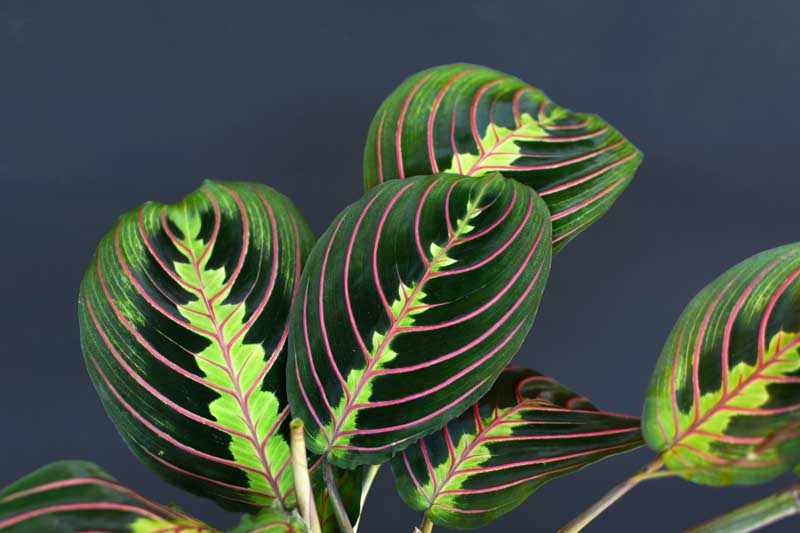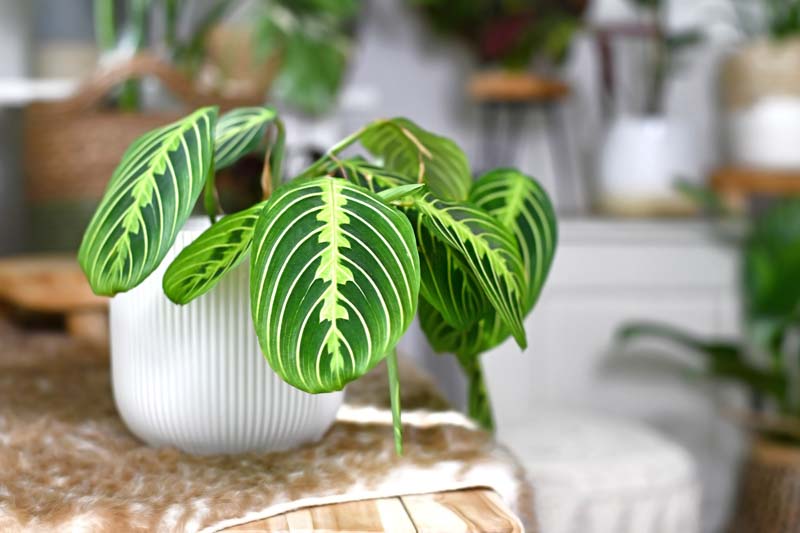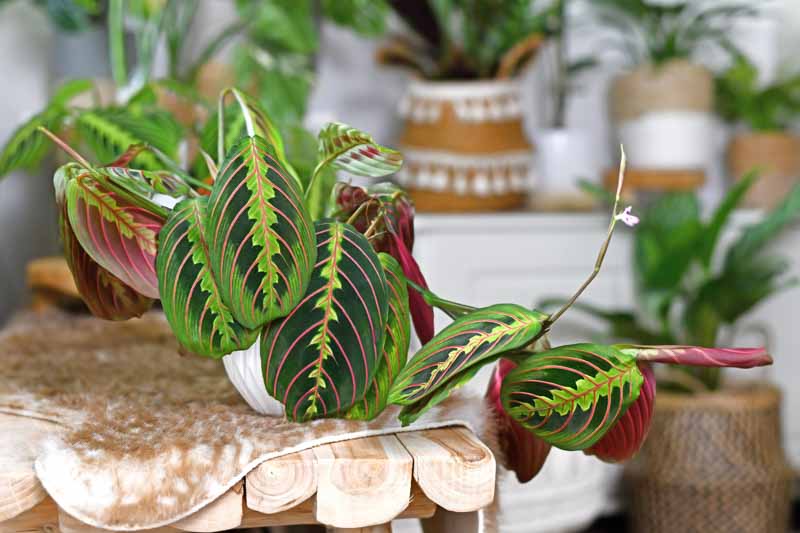Prayer Plant, Ten Commandments
Maranta leuconeura, commonly known as the Prayer Plant, is a visually stunning houseplant that captivates with its unique foliage and intriguing behaviors.
Maranta leuconeura is renowned for its striking leaves that fold together at night, resembling hands in prayer. This fascinating feature, coupled with the plant’s vibrant green leaves adorned with dark spots and lines, makes it a decorative favorite.
Native: Originating from the tropical rainforests of Brazil, the Prayer Plant thrives in warm, humid environments under the canopy of trees where light is filtered and the air is moist. It belongs to the arrowroot family (Marantaceae).
Plant Type and Habit: The Prayer Plant is a rhizomatous, clump-forming perennial that exhibits a low-growing, spreading habit. Its compact size and tendency to spread outward rather than upward make it an ideal plant for indoor settings.
Size: Typically, the Prayer Plant reaches a modest height of 6-12 inches (15-30 cm) with a similar spread, making it a perfect choice for tabletops, shelves, or hanging baskets.
Flowers: The Prayer Plant flower is small, tubular white or light purple. It is produced during the growing season. However, it is not as showy as the leaves and is infrequently seen in indoor conditions.
Foliage: The plant’s most striking feature is its velvety, deep green, elliptic to ovate-shaped leaves with unique variegations, including red veins and patterns ranging from light green to almost white, making each leaf a piece of natural art.
Hardiness: As a tropical plant, it prefers environments that mimic its native habitat—warmth and high humidity. It’s not frost-tolerant and thrives in temperatures between 60°F and 80°F (15°C and 27°C). If grown outdoors, it is best suited to USDA hardiness Zones 11-12.
Uses: It’s often used in interior design to add a touch of nature’s beauty and to create a more tranquil, relaxing environment.
Toxicity: One of the advantages of Maranta leuconeura is its non-toxicity. It is safe for pets and humans, making it a popular choice for households with animals and children.
Benefits: Apart from its aesthetic appeal and air-purifying qualities, the Prayer Plant can have a calming effect on the environment, making spaces feel more serene and inviting.

Caring for a Prayer Plant involves meeting its specific requirements for light, water, humidity, and temperature to ensure healthy growth.
Light: Prayer Plants prefer bright, indirect light. Direct sunlight can scorch the leaves, while too little light can cause the leaves to lose their vibrant patterns. A spot near an east or north-facing window is ideal, providing the plant with gentle morning sunlight and shade for the rest of the day.
Soil: Prayer Plants require well-draining soil rich in organic matter. A mix of peat, perlite, and compost is ideal, providing the necessary moisture retention and aeration to prevent root rot while supporting healthy growth.
Water: Keep the soil consistently moist but not waterlogged. Overwatering can lead to root rot, while underwatering can stress the plant. Use lukewarm water to avoid shocking the plant and allow the top inch of soil to dry out slightly before watering again.
Temperature and Humidity: Ideal temperatures range from 65°F to 80°F (18°C to 27°C). Avoid sudden temperature changes and keep the plant away from drafts, air conditioners, and heating vents.
Prayer Plants are sensitive to cold and should not be exposed to temperatures below 60°F (15°C). These houseplants thrive in high-humidity environments, similar to their native tropical habitat. Increase humidity by placing the plant on a pebble tray filled with water, grouping it with other plants, or using a humidifier.
Fertilization: Fertilize every 4 weeks during the growing season (spring and summer) with a balanced, water-soluble fertilizer diluted to half the recommended strength. Reduce fertilization in fall and winter when the plant’s growth slows.
Pruning: Prune back any yellow or damaged leaves to encourage healthy growth. Regular pruning helps maintain a bushy, attractive shape.
Repotting: Repot in spring every 1-2 years or when the plant becomes root-bound. Use a pot only slightly larger than the previous one to avoid overwatering issues.

Propagating a Prayer Plant can be a rewarding experience, allowing you to create new plants from an existing one. The most common methods for propagating Prayer Plants are through division and stem cuttings.
This method is best performed when repotting your Prayer Plant, typically in the spring.
Stem cuttings are an easy way to propagate Prayer Plants and can be done almost any time of the year.

Prayer Plants are relatively resistant to major problems, but like all indoor plants, they can encounter some pests, diseases, and common issues.
Spider Mites: These tiny pests can be identified by the fine webs they weave on the plant. They cause yellowing or speckled leaves. Increase humidity around the plant and wash it with a strong stream of water. For severe infestations, use insecticidal soap or neem oil.
Mealybugs: These white, cottony pests tend to cluster in leaf axils and under leaves, sucking sap and weakening the plant. Remove with alcohol-dipped cotton swabs or apply neem oil.
Root rot: Overwatering is the primary cause, leading to brown, mushy roots and yellowing leaves. Reduce watering, improve drainage, and repot the plant into fresh, well-draining soil. Severely affected roots should be trimmed before repotting.
Leaf spot: Fungal or bacterial infections can cause dark or black spots on leaves, often with a yellow halo. Increase air circulation, avoid wetting leaves when watering, and remove affected leaves. Fungicides or bactericides may be necessary in severe cases.
Yellow Leaves: Overwatering, poor drainage, or nutrient deficiencies can cause leaves to turn yellow. Adjust watering habits and ensure your plant has a balanced, diluted fertilizer during its growing season.
Brown Leaf Tips or Edges: Often a sign of low humidity or salt build-up from tap water. Increase humidity around the plant and use filtered or distilled water for irrigation.
Curling Leaves: Usually due to underwatering or low humidity. Ensure the plant is receiving enough water and consider using a pebble tray or humidifier to increase humidity.
Fading or Dull Leaves: Lack of light can cause the vibrant patterns on the leaves to fade. Move your Prayer Plant to a brighter location, but avoid direct sunlight, which can scorch the leaves.
Prayer plants are non-toxic to cats and dogs. They are safe to keep in homes with pets, making them a great choice for pet owners who want to add greenery without risking their pets’ health.
The best place for a Prayer Plant is in a location that receives bright, indirect light. They thrive in warm and humid environments that mimic their natural habitat, with protection from direct sunlight, which can scorch their leaves. A spot near a north or east-facing window or slightly shaded by sheer curtains in a south or west-facing window is ideal. Additionally, ensuring the environment is humid will mimic their natural tropical habitat, promoting healthy growth.
Prayer Plants are special for several reasons: Their leaves fold up at night, resembling hands in prayer, which is a fascinating display of plant behavior. They have beautiful, decorative leaves with unique patterns and vibrant colors that can brighten up indoor spaces. Like many houseplants, they help purify the air, although the extent of this benefit can vary.
Prayer Plants can be somewhat challenging to keep alive for beginners due to their specific humidity and watering needs. However, they can be successfully maintained with proper care and attention to their environmental needs.
Prayer Plants can spread and grow fuller over time. They typically do not spread widely but grow more leaves from the central rosette, creating a lush, dense appearance.
To keep your Prayer Plant happy, ensure you’re meeting its needs for humidity, watering, and light. Regularly checking the plant for pests and diseases, keeping it in a suitable environment, and providing the necessary care will keep it healthy and thriving.
| Hardiness |
11 - 12 |
|---|---|
| Plant Type | Houseplants, Perennials |
| Plant Family | Marantaceae |
| Genus | Maranta |
| Common names | Prayer Plant |
| Exposure | Partial Sun |
| Season of Interest |
Spring (Early, Mid, Late) Summer (Early, Mid, Late) Fall Winter |
| Height |
6" - 1' (15cm - 30cm) |
| Spread |
6" - 1' (15cm - 30cm) |
| Maintenance | Low |
| Water Needs | Average |
| Soil Type | Loam, Sand, Chalk, Clay |
| Soil pH | Acid, Neutral, Alkaline |
| Soil Drainage | Moist but Well-Drained, Well-Drained |
| Characteristics | Showy, Evergreen |
| Garden Uses | Patio And Containers |
| Hardiness |
11 - 12 |
|---|---|
| Plant Type | Houseplants, Perennials |
| Plant Family | Marantaceae |
| Genus | Maranta |
| Common names | Prayer Plant |
| Exposure | Partial Sun |
| Season of Interest |
Spring (Early, Mid, Late) Summer (Early, Mid, Late) Fall Winter |
| Height |
6" - 1' (15cm - 30cm) |
| Spread |
6" - 1' (15cm - 30cm) |
| Maintenance | Low |
| Water Needs | Average |
| Soil Type | Loam, Sand, Chalk, Clay |
| Soil pH | Acid, Neutral, Alkaline |
| Soil Drainage | Moist but Well-Drained, Well-Drained |
| Characteristics | Showy, Evergreen |
| Garden Uses | Patio And Containers |
How many Maranta leuconeura (Prayer Plant) do I need for my garden?
| Plant | Quantity | |
|---|---|---|
| Maranta leuconeura (Prayer Plant) | N/A | Buy Plants |
Create a membership account to save your garden designs and to view them on any device.
Becoming a contributing member of Gardenia is easy and can be done in just a few minutes. If you provide us with your name, email address and the payment of a modest $25 annual membership fee, you will become a full member, enabling you to design and save up to 25 of your garden design ideas.
Join now and start creating your dream garden!
Create a membership account to save your garden designs and to view them on any device.
Becoming a contributing member of Gardenia is easy and can be done in just a few minutes. If you provide us with your name, email address and the payment of a modest $25 annual membership fee, you will become a full member, enabling you to design and save up to 25 of your garden design ideas.
Join now and start creating your dream garden!